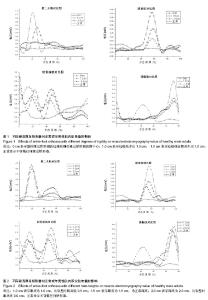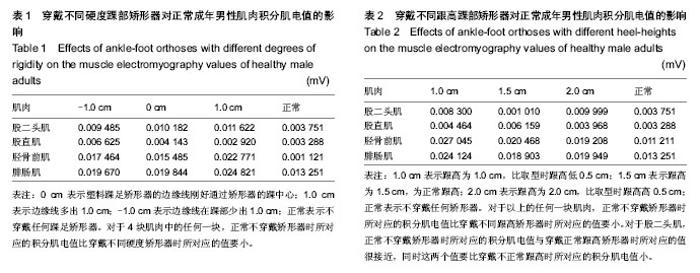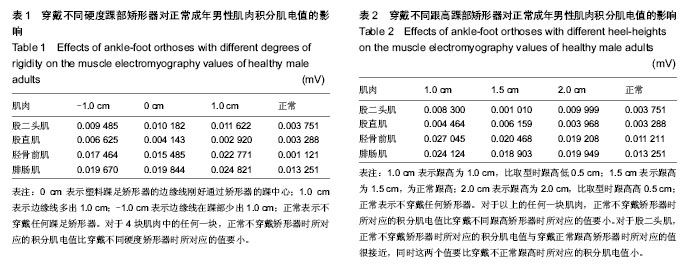| [1] 赵辉三.假肢与矫形器学[M].北京:华夏出版社,2005:154-167.
[2] 谭先军.下肢矫形器的原理剖析[J].社会福利,2003,12(1):55-56
[3] 李高峰,方新.矫形器产品的功能考量[J].中国组织工程研究与临床康复,2006,10(37):134-135.
[4] Lamb PF,Mundermann A,Bartlett RM,et al.Visualizing changes in lower body coordination with different types of foot orthoses using self-organizing maps (SOM). 2011;34(4): 485-489.
[5] 陈秀恩,左群.踝足矫形器在痉挛型脑瘫患儿术后康复治疗中的作用[J].中国康复医学杂志,2007,22(2):174-175.
[6] 郁嫣嫣,祁奇,吴卫青,等.踝足矫形器对脑卒中患者步行功能恢复的影响[J].中国康复医学杂志,2006,21(2):157-158.
[7] Huang YC,Harbst K,Kotajarvi B,et al.Effects of ankle-foot orthoses on ankle and foot kinematics in patients with subtalar osteoarthritis.Arch Phys Med Rehabil.2006;87(8):1131-1136.
[8] Romkes J,Hell AK,Brunner R.Changes in muscle activity in children with hemiplegic cerebral palsy while walking with and without ankle-foot orthoses.Gait Posture.2006;24(4):467-474.
[9] 周大伟,杨建坤.固定式踝足矫形器对下肢的影响[J].中国康复医学杂志,2006,21(9):829-831.
[10] 王健.sEMG信号分析及其应用研究进展[J].体育科学, 2000, 20(4): 56-60.
[11] 王奎,刘建红,宋刚.sEMG技术在评价运动性疲劳方面的方法及应用[J].安徽体育科技,2004,25(3):49-51.
[12] 杨晓华,熊开宇.积分肌电对青年男子骨四头肌的疲劳评价[J].沈阳体育学报,2004,23(3):384-386.
[13] 陈胜利,张立.表面肌电信号分析评价肌肉疲劳的有效性和敏感性[J].武汉体育学院学报,2011,45(12):71-77.
[14] 袁爱国,史昭蓉,何彩艳,等.运动性肌肉疲劳的肌电图特征及其机制探讨[J].四川体育科学,2006,25(3):36-39.
[15] 李秀荣,王景责,张立.运动中肌肉氧含量下降与肌肉疲劳的关系[J].武汉体育学院学报,2004,38(2):63-64.
[16] 赵正全,苏强.矫形器在脑血管意外中的应用[J].中国康复,2001, 16(2):109-110.
[17] 李哲,郭钢花.动态式踝足矫形器对偏瘫患者步行能力的影响[J].中国康复医学杂志,2007,22(11):1018-1019.
[18] 方新.为痉挛型脑瘫患儿设计的功能性踝足矫形器[J].中国康复, 2003,18(4):209-210.
[19] 柳淑芬.踝足矫形器在小儿脑瘫康复中的应用及护理[J].临床护理杂志,2011,10(1):43-44.
[20] 黄月艳,李强,陈霞静.踝足矫形器对脑性瘫痪患儿步态功能的改善作用[J].中国组织工程研究与临床康复, 2009,13(9): 1691-1694.
[21] 吕智海,张震,时人杰,等.踝足矫形器提高痉挛型脑性瘫痪患儿运动功能的研究[J].中国中西医结合儿科学,2012,4(1):25-27.
[22] Sutherland DH. The evolution of clinical gait analysis. Part II kinematics.Gait Posture.2002;16(2):159-179.
[23] Chen CL,Yeung FT,Wang CH,et al.Anterior ankle-foot orthosis effects on postural stability in hemiplegic patients.Arch Phys Med Rehabil.1999;80:1587-1592.
[24] Bono CM,Berbetian WS.Orthosis devices:Degenerative disorders of the foot and ankle.Foot Ankle Clin. 2001;6: 329-340.
[25] Woodburn J,Barker S,Helliwell PS.A randomized controll edtrial of foot orthoses in rheumatoid arthritis.J Rheurnatol. 2002;29(7):1377-1383.
[26] Simpson KJ,Cravens S,Higbie E,et al.A comparison of the Sport Stirrup, Malleoloc, and Swede-O ankle orthoses for the foot-ankle kinematics of a rapid lateral movement.Int JSports Med.1999;20(6):396-402.
[27] Imhauser CW,Abidi NA,Frankel DZ,et al.Biomechanical evaluation of the efficacy of external stabilizers in the conservative treatment of acquired flatfoot deformity.Foot Ankle Int.2002;23(8):727-737.
[28] Wu KK.Foot orthoses:principles and clinical applications. Baltimore(MD):Williams&Wilkim,1990.
[29] Wu SH.An anterior direct molding ankle-foot orthosis.J OccupTher Assoc ROC.1992;10:75-81.
[30] 赵文汝,赵海红,霍剑菲,等.缓释力足踝矫形器的研制及临床应用[J].中国康复医学杂志,2007,22(12):1097-1098.
[31] 易南,王冰水,王斌,等.带楔鞋与硬踝足矫形器联合应用对膝屈曲脑性瘫痪儿童膝关节伸展能力的改善效应[J].中国组织工程研究与临床康复,2007,11(5):900-902.
[32] 孟殿怀,王彤,李涛.改良式踝足矫形器对膝关节运动角度的影响[J].中国康复医学杂志,2007,22(4):326-328.
[33] Gottschall JS, Kram R.Energy cost and muscular activity required for propulsion during walking.J Appl Physiol (1985). 2003;94(5):1766-1772.
[34] Ferris DP,Czerniecki JM,Hannaford B.An ankle-foot orthosis powered by artificial pneumatic muscles.J Appl Biomech. 2005; 21(2):189-197.
[35] Gordon KE,Sawicki GS,Ferris DP.Mechanical performance of artificial pneumatic muscles to power an ankle-foot orthosis.J Biomech.2006;39(10):1832-1841. |



